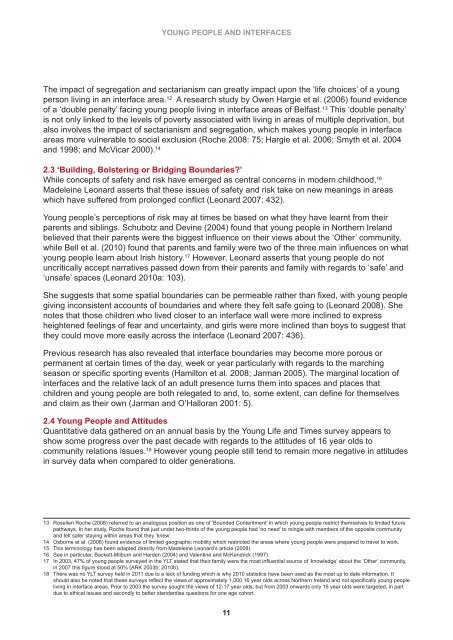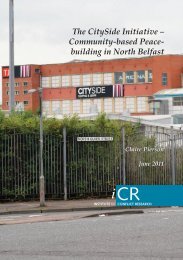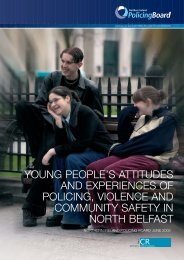Young People and Interfaces Report - Institute for Conflict Research
Young People and Interfaces Report - Institute for Conflict Research
Young People and Interfaces Report - Institute for Conflict Research
Create successful ePaper yourself
Turn your PDF publications into a flip-book with our unique Google optimized e-Paper software.
YOUNG PEOPLE AND INTERFACES<br />
The impact of segregation <strong>and</strong> sectarianism can greatly impact upon the ‘life choices’ of a young<br />
person living in an interface area. 12 A research study by Owen Hargie et al. (2006) found evidence<br />
of a ‘double penalty’ facing young people living in interface areas of Belfast. 13 This ‘double penalty’<br />
is not only linked to the levels of poverty associated with living in areas of multiple deprivation, but<br />
also involves the impact of sectarianism <strong>and</strong> segregation, which makes young people in interface<br />
areas more vulnerable to social exclusion (Roche 2008: 75; Hargie et al. 2006; Smyth et al. 2004<br />
<strong>and</strong> 1998; <strong>and</strong> McVicar 2000). 14<br />
2.3 ‘Building, Bolstering or Bridging Boundaries?’<br />
While concepts of safety <strong>and</strong> risk have emerged as central concerns in modern childhood, 16<br />
Madeleine Leonard asserts that these issues of safety <strong>and</strong> risk take on new meanings in areas<br />
which have suffered from prolonged conflict (Leonard 2007: 432).<br />
<strong>Young</strong> people’s perceptions of risk may at times be based on what they have learnt from their<br />
parents <strong>and</strong> siblings. Schubotz <strong>and</strong> Devine (2004) found that young people in Northern Irel<strong>and</strong><br />
believed that their parents were the biggest influence on their views about the ‘Other’ community,<br />
while Bell et al. (2010) found that parents <strong>and</strong> family were two of the three main influences on what<br />
young people learn about Irish history. 17 However, Leonard asserts that young people do not<br />
uncritically accept narratives passed down from their parents <strong>and</strong> family with regards to ‘safe’ <strong>and</strong><br />
‘unsafe’ spaces (Leonard 2010a: 103).<br />
She suggests that some spatial boundaries can be permeable rather than fixed, with young people<br />
giving inconsistent accounts of boundaries <strong>and</strong> where they felt safe going to (Leonard 2008). She<br />
notes that those children who lived closer to an interface wall were more inclined to express<br />
heightened feelings of fear <strong>and</strong> uncertainty, <strong>and</strong> girls were more inclined than boys to suggest that<br />
they could move more easily across the interface (Leonard 2007: 436).<br />
Previous research has also revealed that interface boundaries may become more porous or<br />
permanent at certain times of the day, week or year particularly with regards to the marching<br />
season or specific sporting events (Hamilton et al. 2008; Jarman 2005). The marginal location of<br />
interfaces <strong>and</strong> the relative lack of an adult presence turns them into spaces <strong>and</strong> places that<br />
children <strong>and</strong> young people are both relegated to <strong>and</strong>, to, some extent, can define <strong>for</strong> themselves<br />
<strong>and</strong> claim as their own (Jarman <strong>and</strong> O’Halloran 2001: 5).<br />
2.4 <strong>Young</strong> <strong>People</strong> <strong>and</strong> Attitudes<br />
Quantitative data gathered on an annual basis by the <strong>Young</strong> Life <strong>and</strong> Times survey appears to<br />
show some progress over the past decade with regards to the attitudes of 16 year olds to<br />
community relations issues. 18 However young people still tend to remain more negative in attitudes<br />
in survey data when compared to older generations.<br />
13 Rosellen Roche (2008) referred to an analogous position as one of ‘Bounded Contentment’ in which young people restrict themselves to limited future<br />
pathways. In her study, Roche found that just under two-thirds of the young people had ‘no need’ to mingle with members of the opposite community<br />
<strong>and</strong> felt safer staying within areas that they ‘knew’.<br />
14 Osborne et al. (2006) found evidence of limited geographic mobility which restricted the areas where young people were prepared to travel to work.<br />
15 This terminology has been adapted directly from Madeleine Leonard’s article (2008).<br />
16 See in particular, Backett-Milburn <strong>and</strong> Harden (2004) <strong>and</strong> Valentine <strong>and</strong> McKendrick (1997).<br />
17 In 2003, 47% of young people surveyed in the YLT stated that their family were the most influential source of ‘knowledge’ about the ‘Other’ community,<br />
in 2007 this figure stood at 50% (ARK 2003b; 2010b).<br />
18 There was no YLT survey held in 2011 due to a lack of funding which is why 2010 statistics have been used as the most up to date in<strong>for</strong>mation. It<br />
should also be noted that these surveys reflect the views of approximately 1,000 16 year olds across Northern Irel<strong>and</strong> <strong>and</strong> not specifically young people<br />
living in interface areas. Prior to 2003 the survey sought the views of 12-17 year olds, but from 2003 onwards only 16 year olds were targeted, in part<br />
due to ethical issues <strong>and</strong> secondly to better st<strong>and</strong>ardise questions <strong>for</strong> one age cohort.<br />
11






